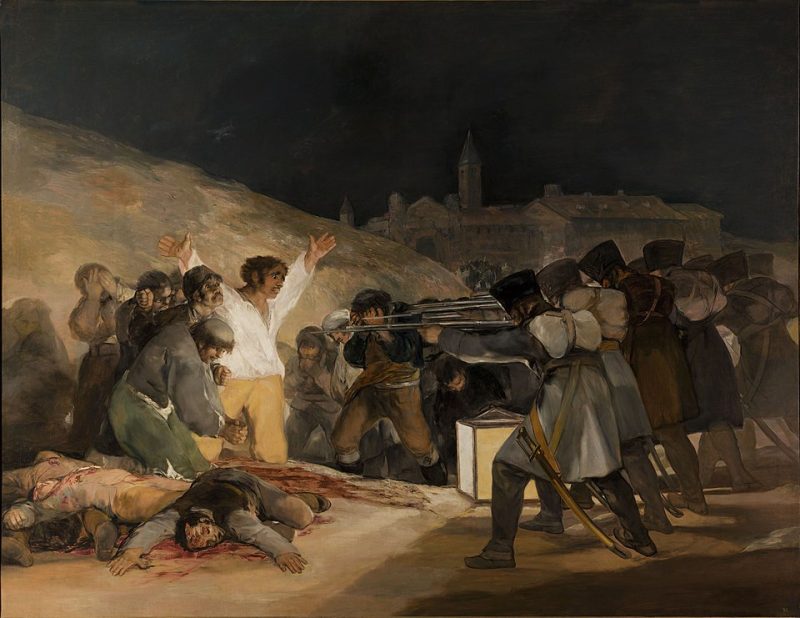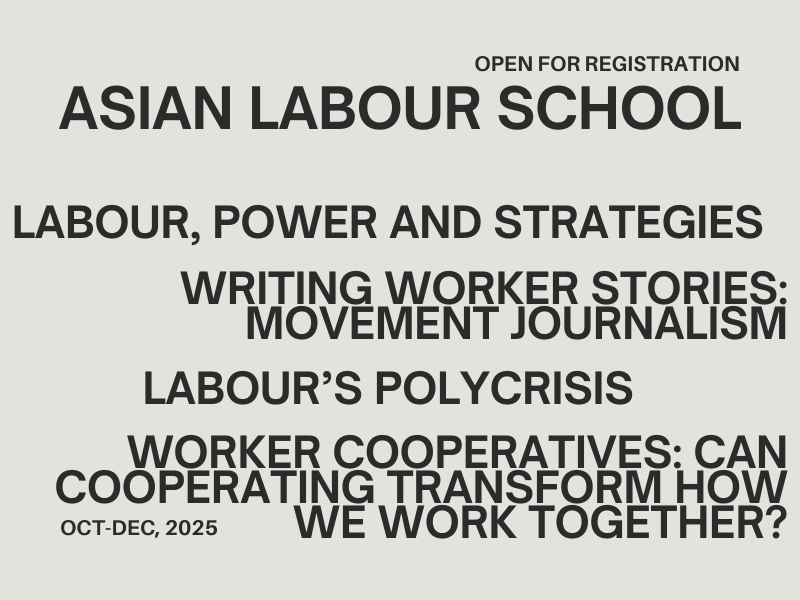On the eve of Labour Day 2025 in Jakarta, a WhatsApp message from a friend posed a deceptively simple question: “Are you attending the demonstration at Monas (National Monument) or DPR (the House of Representatives)?” Personally, this question felt loaded. Answering seemed to demand alignment with one of two distinct poles: either shaking hands with the government at the state-sanctioned rally at Monas, or clenching my fists in protest at the DPR. Despite the union where I work being part of the organising committee of the ‘May Day Fiesta’ at Monas, I’ve always considered the people who organise the protest at the DPR as friends. After a moment of hesitation, I chose an honest, objective response: “Brother, I’ll go to Monas first and then join my friends at the DPR later.”
May Day Fiesta: Those Who Shake Hands
My partner and I took the Commuter Line train and then walked to Monas, our first May Day together. Along the way, we saw crowds in matching white T-shirts with red sleeves. “Oh, so many people brought their families,” my partner whispered, a bit confused, “or are these paid crowds for President Prabowo?”. I pondered before replying, “A few years back, we were encouraged to bring our families so they could also understand the struggles we face”. As we entered the Monas area, I started to see the familiar Union logos. “Ah, here’s the labour crowd I recognise!” I gleefully told her.
The stage visuals at Monas immediately reminded me of Cold War-era Eastern Bloc propaganda. I was particularly struck by the huge visual that serves as the background on the podium. The image of a row of smiling, likely Caucasian, people raising their fists in unison, rendered with stark shading and lighting. I wondered if I was overthinking it, or if the designer simply lacked this historical context, or perhaps used a basic AI prompt in creating these images.
Before the event began, the audience was entertained by the ska music of the popular band Tipe-X. After an hour, celebrity entrepreneur Raffi Ahmad took the stage as the host. He was recently appointed as the President’s Special Envoy for the young generation, a newly created position by the President after his inauguration in October of the previous year. The MC repeatedly led a chant of, “Long live the workers! Workers unite, defend the nation,” which confused those around me who were used to shouting the traditional slogan, “Workers united will never be defeated!”.
Shortly after, the Secretary-General of the International Trade Union Confederation (ITUC) Asia Pacific, Shoya Yoshida, opened the event. Three of the four confederations organising the event – KSBSI (Konfederasi Serikat Buruh Seluruh Indonesia or the Confederation of All Indonesian Trade Unions), KSPSI-AGN (Konfederasi Serikat Pekerja Seluruh Indonesia-AGN or the Confederation of All Indonesian Trade Unions under the leadership of Andi Gani), and KSPI (Konfederasi Serikat Pekerja Indonesia or the Indonesian Trade Union Confederation) – are affiliates of the ITUC.
These confederations are also historically part of a coalition called MPBI (Majelis Pekerja Buruh Indonesia or the Indonesian Workers’ Council), which in 2012 and 2013 called for a national strike. Along with them, the leader of KSPSI-Jumhur (Konfederasi Serikat Pekerja Seluruh Indonesia-Jumhur or the Confederation of All Indonesian Trade Unions under the leadership of Jumhur Hidayat) is also present.
When the leaders of the four major labour confederations came on stage, they were asked to give a “report” to the President. An interesting choice of words, as giving “report”, seemed to show that four of them are directly under the President’s authority. The four leaders lined up awkwardly, facing President Prabowo, who was listening to their “report” while sitting on his chair. This situation is looking weird for us, and so unlike their usual fierce demeanour when leading us in mass actions.
Then came President Prabowo’s speech – the first by a president who attended the May Day since Sukarno in 1965 – where he made a series of extraordinary promises. President Prabowo promised the creation of the National Labour Welfare Council, an Anti-Layoff Task Force, ratification of the Domestic Workers Protection Bill, abolishing outsourcing, recognising the murdered labour activist Marsinah as a national hero, supporting the Asset Seizure Law, and reviewing the progressive tax on workers. If all of these were fulfilled, the hope for workers’ welfare in this country could finally become a reality.
But what happened after the speech ended was even more shocking. I never imagined that the President, a former military general from the New Order regime, would be on stage as the melody of “The Internationale” played. The crowds erupted, chanting the name of President Prabowo as some people sang a song considered taboo during the New Order era. At that moment, I wondered quietly to myself, “Perhaps it’s me who is still rooted in the old tradition, still standing on the very foundation I have long been singing about tearing down.”
May’s Resistance: Those Who Clench Their Fists
After lunch, we headed to the DPR building. The contrast was immediate. The crowd was younger and more energetic. A speaker on a command vehicle (mobil komando) from the F-SEDAR union (Federasi Serikat Buruh Demokratik Kerakyatan or the Federation of Democratic People’s Labour Unions) loudly called for a boycott of Aice, an ice cream company originating from Singapore, over alleged worker exploitation. We chatted briefly with members of the airport workers union, FSPBI (Federasi Serikat Pekerja Bandara Indonesia or the Federation of Indonesian Airport Workers’ Unions), whose stylish red and yellow T-shirts bore the words “We Move the World”.
The banners here were creatively designed, and my partner documented them enthusiastically. “The design is cool, the words are interesting,“ she said. This was likely the influence of SINDIKASI, the union for media and creative workers, a key member of the GEBRAK alliance organising the protest. GEBRAK stands for Gerakan Buruh Bersama Rakyat, or the Labour Movement Together with People, an alliance of labour unions, student-youth organisations, environmental organisations, farmers, academics, women, and civil society organisations. Live music and bands can also be heard in this location. Rather than a well-established ska band, indie bands like The Brandals and The Jansen provided a soundtrack more suitable for headbanging, not dancing.
The gathering in front of the DPR was not merely to commemorate the Haymarket incident or the fight for an eight-hour workday. It was a convergence of people united by a shared sense of oppression and the injustices that persist across Indonesia. Among them were environmental activists such as Greenpeace, human rights defenders like KontraS, and advocates for justice in Papua. For them, May Day is not a festive occasion or a fiesta—it is a day of struggle, a day to rebuke the government for allowing systemic injustices to endure.
Not far from the stage where live music is played, people started to flock to a command mobile bearing blue-colored flags. I wasn’t surprised to hear a strong narrative from the GSBI union (Gabungan Serikat Buruh Indonesia or the Centre of Indonesian Labour Struggle) demanding the abolition of imperialism, feudalism, and bureaucratic capitalism, as they have consistently raised these issues since I first met them. While listening to them, I recalled stories from my seniors in KSBSI who fought during the New Order, running from the police and military. “Ah, how beautiful is the spirit of struggle shouted by these comrades.“ Before we left, I was happy to see a few union members I recognised from Monas who had come in their personal capacity to show solidarity with their fellow labour activists. I took it as a sign that there are people who share my opinion, that the struggle of the workers should be fought by all the workers, regardless of their organisational direction or political divides.
Reflection: From Polarisation to Solidarity?
Back home, I reopened my thesis notes, and the day’s events began to crystallise. The invisible wall I had often sensed between the two sides became starkly visible during this past May Day, exposing the labour movement’s deep polarisation. The split into two distinct poles – the collaborative rally at Monas and the confrontational protest at the DPR – is an evolution from the simple fragmentation that followed the end of the New Order in 1998. That earlier era saw unions emerge and splinter so fast that even movement veterans couldn’t name them all. Today’s situation, with two identifiable and opposing camps, may be more dangerous in dividing the labour movement.
Differences in understanding what a labour union is and how it should work are not a new discussion. In his book Understanding European Trade Unionism (2001), Richard Hyman outlines union logics that help explain this divide. The Monas rally exemplified market-focused unionism, which uses lobbying and social dialogue as its strategy to provide services and secure immediate gains for its members. On the other hand, the DPR protest embodied class-focused unionism, which sees an inherent antagonism between workers and capital and uses direct action and strong ideology to challenge the entire system. This division worsened by leadership rivalries and a tendency to ‘demonise’ the other side. For instance, those who engage with the government are often branded as ‘puppets,‘ while those who protest are dismissed as ideologues with ‘no tangible results.‘ Over time, the invisible wall slowly hardens into a concrete one, cementing the movement into an entrenched ‘us versus them‘ divide.
Indonesia has longed for unity within the labour movement since the dawn of the Reformasi Era in 1998. The Labour Party’s re-emergence in the 2024 General Election, after its absence in the previous two elections, can be seen as an attempt to unite various elements of the labour movement under a political party. While led by Said Iqbal (President of KSPI), the party also has representatives from both market-focused and class-focused unions. However, the reality remains far from ideal. The less-than-expected results and the labour movement’s lack of unity in supporting the Labour Party raise major questions about its ability to demonstrate solidarity or act collectively under one political entity. Rather than signalling a promise of unity, it illustrates the inability of both sides to effectively mobilise their base at the ballot box.
Still, I see hope. Within the Labour Party, union confederations like KPBI (Konfederasi Persatuan Buruh Indonesia or the Confederation of United Indonesian Workers) and Kompolnas (National Political Commission – the progressive wing within the Labour Party) demonstrate the potential to act as a ‘bridge,‘ uniquely positioned to connect these two distinct logics. Through their nuanced approaches to advocacy and engagement, they offer a path towards greater unity. The movement urgently needs more such bridges — not only within the party, but across the broader labour movement, from labour leaders and union members to every sympathiser of the cause. Change must come to the movement, and it must begin with us.
I hope that the polarisation seen on May Day is not the end of our hope in a united labour movement in Indonesia. The promises made at Monas must be guarded, and that requires consistent pressure from mass actions like those at the DPR and strategic discussions with the policymakers. Let us not allow our differences to obscure the fact that when we all return home, we are all workers striving to provide the best for our families. For too long, we’ve been butting heads with each other, and it’s time for us to start coming together.
*This article is a personal reflection on the author’s May Day 2025 experiences, originally published in Indonesian as “Berjabat Tangan ataupun Mengepalkan Tangan, Kenapa Kita Tidak Saling Berangkulan? Sebuah Refleksi May Day 2025” (Shaking Hands or Clenching Fists, Why Don’t We Just Hug Each Other? A Reflection on May Day 2025) on Majalah Sedane. It has been shortened and edited. The author thanks Jeffrey Hermanson for his initial full English translation and encouragement to publish it on the ALR. All views expressed are solely the author’s and do not reflect any organisation.


